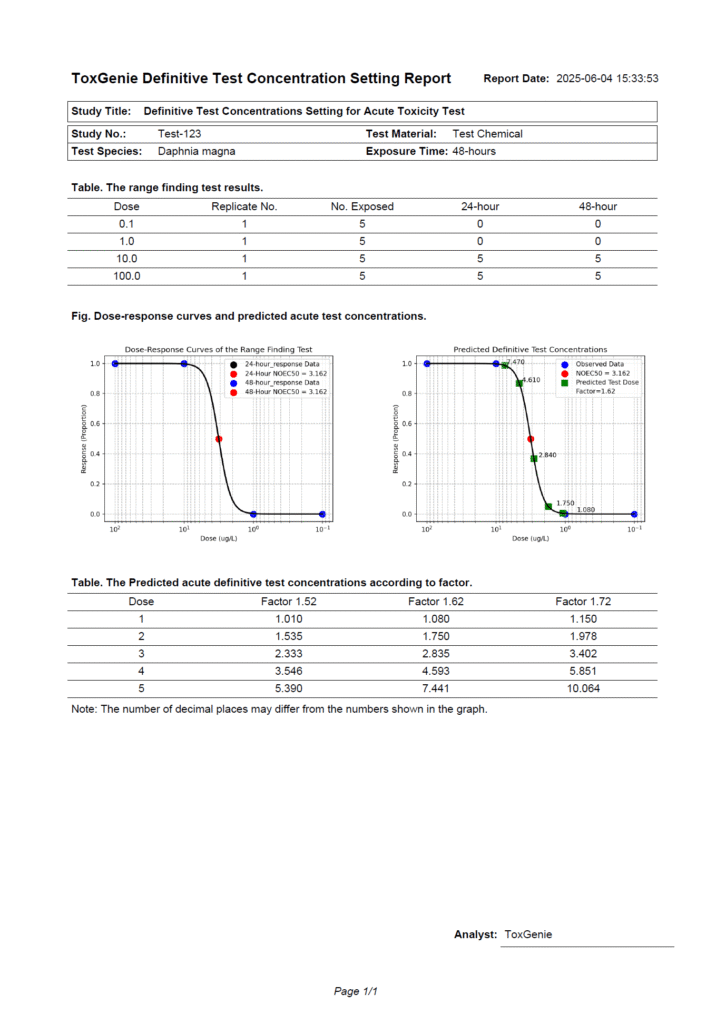In ecotoxicity testing, the range-finding test contains more information than one might expect, and analyzing preliminary test data through graphical representations is essential for interpreting results and determining definitive test concentrations. This post outlines key considerations for establishing a concentration range that includes a 100% effect concentration and at least two partial effect concentrations across 5–6 test concentrations (excluding the control). It also addresses specific considerations for acute toxicity tests with Daphnia and fish, emphasizing the importance of observing toxicity symptoms during the preliminary test.
Key Considerations for Setting the Definitive Test Concentration Range
The primary goal of the range-finding test is to define the concentration range for the definitive test that fully characterizes the toxicological response of the test substance. According to OECD Test Guidelines, a geometric factor of 10 is typically used, resulting in four concentrations, such as 0.1, 1, 10, and 100. Based on my experience, I recommend setting the highest concentration at the maximum water solubility of the test substance and determining the preliminary test concentrations downward from there. It is also advisable to consider the exposure duration of the definitive test when conducting observations and measurements.
Changes in 0% and 100% Effect Concentrations
It is critical to observe whether the 0% effect concentration and 100% effect concentration change as the exposure duration increases during the preliminary test. Generally, beyond a certain time point, the 0% and 100% effect concentrations remain stable. However, depending on the characteristics of the test substance, these concentrations may decrease as exposure time extends. In such cases, the observation period should be prolonged.
Observation Timing for 100% Effect Concentration
During the range-finding test, it is preferable to observe as frequently as possible within the first 24 hours. If a 100% effect is observed within this timeframe, it provides critical information for determining the highest concentration in the definitive test.
Importance of Recording Toxicity Symptoms
Documenting toxicity symptoms, such as behavioral changes or other sublethal effects, during the range-finding test is crucial. These observations provide valuable insights into the test substance’s mode of action and stability. For example, if toxicity symptoms are observed early in the exposure but the test organisms recover over time, this may indicate that the test substance’s concentration is not maintained throughout the test period, possibly due to degradation, volatilization, or adsorption. Such findings suggest the need to adjust the definitive test design, for instance, by adopting semi-static or flow-through systems.
Collection of Literature Information
Analyzing all available information on the test substance, including physicochemical properties, database searches (e.g., ECOTOX), and relevant papers or reports, is highly important. In particular, reviewing the Material Safety Data Sheet (MSDS) for the test substance is critical for ensuring the safety of researchers.
Determining Definitive Test Concentrations
Determining definitive test concentrations is not a straightforward task and often requires experience and expertise. Therefore, it is essential to gather as much relevant information as possible during the preliminary test to inform the definitive test concentration range. For instance, in acute toxicity tests with fish conducted per OECD Test Guideline 203, 5–6 test concentrations (excluding the control) should be selected within a range that does not exceed the maximum geometric factor to accurately capture the dose-response relationship.

Start Analyzing with ToxGenie
ToxGenie analyzes range-finding test results from acute and chronic toxicity tests and recommends definitive test concentrations (see figure). However, as noted earlier, determining definitive test concentrations based on limited information is not easy. The most accurate decisions are made by the researcher who conducted the preliminary test. ToxGenie suggests up to three definitive test concentrations within a range that does not exceed the maximum geometric factor, but the final decision rests with you.
Interested? Start with a 30-day free trial and revolutionize your toxicity data statistical analysis today!
